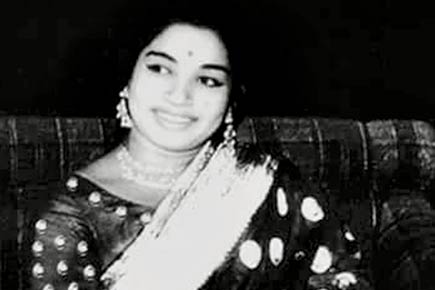Excerpts from an upcoming book on the late chief minister Tamil Nadu J Jayalalithaa, who was laid to rest next to her mentor MGR on Tuesday


J Jayalalithaa
The shrewd politician that MG Ramachandran was, he struck when the iron was hot. Jayalalithaa was in a phase of life when she could be induced to join politics; she no longer wanted to do films, she was looking for change, something more engaging perhaps.
ADVERTISEMENT
The DMK and its shining stars led the second anti-Hindi agitation in 1965 and road-rolled into the legislative assembly in 1967, ousting the Congress from power in the state for 50 years.
Jayalalithaa grew into adulthood during these years of dramatic politics and cultural consciousness. In 1967, Annadurai became the Chief Minister, but when he died within two years, M Karunanidhi became the CM, although MGR was the DMK’s star attraction. MGR exited the DMK in 1972. He took half the DMK with him and set up the Anna-DMK. The ADMK kept DMK out of power for the next 10 years.
Photos: Former Tamil Nadu's Chief Minister Jayalalithaa's final journey
MGR was perhaps more omniscient than one gives him credit for. He saw the need to be different. His vote bank was thousands and thousands of admiring women. On the national stage in the ’70s was Indira Gandhi, groomed in the 1960s by Nehru to be his successor. She was a larger-than-life leader and MGR was not past understanding the need for a woman leader. By the end of the ’70s, MGR had won a kingdom but had no heir. He had a winning party but no lieutenant. There was Jayalalithaa, 30 years younger, distraught by the loss of her mother, looking for a change in her life. Jayalalithaa, Tamil Nadu’s top actor, no longer wanting to continue acting. Jayalalithaa, beautiful, young, educated, a career woman able to express herself, engaging, ambitious, with a fan-following of her own. Jayalalithaa, with a mind of her own, who would not be any man’s puppet. There was Jayalalithaa, ready to learn and with a terrific mass appeal. Who better than Jayalalithaa?
Jayalalithaa was multifaceted, she had proven her organising ability when she was organising musicals and dance dramas; a large votebank was already her followers. In 1979, MGR had asked her to join the party but she had not then made up her mind.
Jayalalithaa officially joined the ADMK in 1982 and was made its Propaganda Secretary. Conservative senior leaders in the party, formerly of the DMK, did not like this, but grassroots party workers loved her. She campaigned for the ADMK for the Tiruchendur assembly election in 1983 and the party won this seat. This campaign gave her a taste of electoral politics—the adrenalin that an election generates. In 1983, Jayalalithaa spoke at a public rally and ‘that was the turning point in her political career’, recalls a party colleague of that time.
To quell jealousies perhaps, in 1984 MGR sent her to the Rajya Sabha, where she proved to be an able ADMK spokesperson till 1989, when she returned to the state as leader of a splintered ADMK. Jayalalithaa made numerous friends in New Delhi, including Rajiv Gandhi; the exposure taught her the art of managing coalitions.
Jayalalithaa led the ADMK to victory in the 1984 assembly elections despite MGR not campaigning. MGR returned to Chennai in February 1985 and died two years later. By the beginning of 1989, Jayalalithaa supporters had filed petitions before Chief Election Commissioner Peri Shastri to be allotted the ADMK symbol. In February 1989, the SC gave the party building and the ‘two leaves’ symbol and flag to the united AIADMK under Jayalalithaa’s leadership. Jayalalithaa also had the support of MGR’s nephew and niece.
In early 1989, Jayalalithaa was elected to the Tamil Nadu Legislative Assembly from the Bodinayakkanur constituency. In the 1989 general elections, the ADMK won 38 of Tamil Nadu’s 39 Lok Sabha seats. This election saw the Jayalalithaa-led faction of the AIADMK win 27 seats and Jayalalithaa became the first woman to be elected Leader of the Opposition.
Watch video: Funeral procession of Jayalalithaa
On January 31, 1991, President’s Rule was imposed in Tamil Nadu and continued till June 24, 1991. Jayalalithaa in a press conference told the people that her party’s ‘revolutionary voyage’ to oust the DMK from power had begun. Even as a furious Jayalalithaa bided her time, the young Congress leader Rajiv Gandhi, then out of power, was assassinated in Tamil Nadu while he was on a pre-poll tour in May 1991. He had been a friend and Jayalalithaa’s AIADMK allied with the then Congress (I) to win 225 out of the 234 sests in the 10th legislative assembly. The Jayalalithaa-led AIADMK contested and won all 40 constituencies in the Lok Sabha elections too. MGR-Jayalalithaa films and film songs were the party’s campaign tools. The Hindu said, ‘Landslide, wave and sweep understate the Jayalalithaa performance at the hustings’. In June that year, Jayalalithaa became Chief Minister for the first time.
Excerpted from the soon-to-be published book, Being Jayalalithaa by Papri Sri Raman
 Subscribe today by clicking the link and stay updated with the latest news!" Click here!
Subscribe today by clicking the link and stay updated with the latest news!" Click here!







